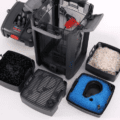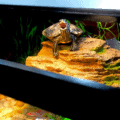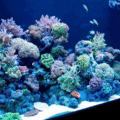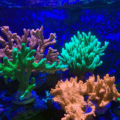I wish someone had told me how to handle my first hammerhead and save me all the time I spent researching it.
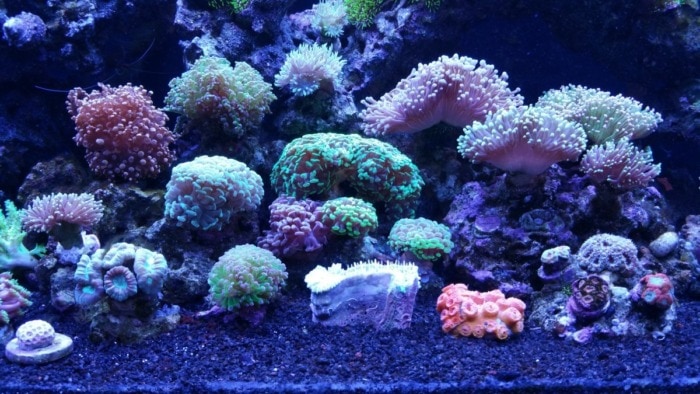
I couldn’t have known, for example, that the hammerhead coral growth rate would force me to relocate the thing soon after getting it.
I learned that when dealing with LPS corals flow intensity can be the difference between life and death.
Finding the right position for hammerheads can be difficult because they are as aggressive as they are fragile.
The wrong place in your aquarium can result in your hammer coral not opening at all.
Not to mention damage to your other corals.
Let’s just get straight to the point.
It is a Large polyp stony coral (LPS) which means it has a sharp calcium carbonate-based skeleton and pronounced soft polyps.
It comes in many different colors that become fluorescent under dark light.
Factors that impact Hammerhead coral positioning
Here’s what you need to know before placing a Hammerhead coral in your fish tank:
Choosing the best position for a hammer coral begins with flow and lighting management. For optimum growth and coloration, you should aim for a PAR of 100 and a medium, indirect water flow. Moreover, placing it at the medium level of the tank seems to work best as it tends to expand the most there.

by xtremecorals
However, you should place it at least 7 or 8 inches away from other corals as its sweepers will extend up to 6 inches during the night. The sweepers will sting other corals, being especially harmful to the SPS ones.
Even though these corals prefer to be “under the spotlight”, they can gradually adapt to any lighting later on.
Tip: Note where the coral was at the fish store and try to recreate that if in doubt.
You can experiment by monitoring for retraction.
If the coral expands, then it feels comfortable and you have nothing to worry about.
It also likes being around frogspawn a lot. Branching hammer corals do very well on mid-rock work.
Despite their substrate proclivity, branching hammer corals do very well on mid-rock work too.
However, you should keep in mind that they might get knocked off by turbo snails or other vigorous tank mates.
Experiment with the placement until your Hammerhead Coral feels comfortable
Don’t be afraid to experiment, as I did.
At first, I put my hammerhead higher in my tank, positioning it middle to top on my rock work.
A higher flow was present there making it jiggle a lot, which seemingly, it didn’t like.
The polyps were very retracted, so I switched to the bottom of the tank where the light was lower.
The water flow was still present, but it was not direct.
After only two hours, my hammer coral had expanded all of its polyps and seemed really happy.
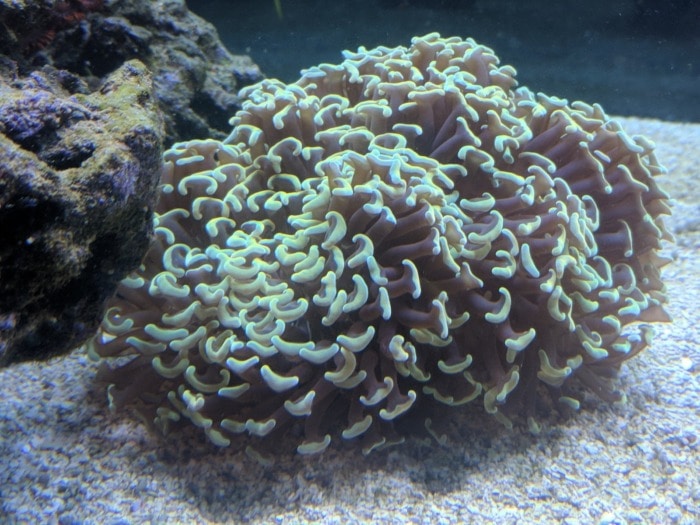
by Greybeard
With time I found that I could even put it at the top of my tank, as long as there wasn’t a direct flow.
I am also positive that these guys enjoy a somewhat pulsating flow.
Let’s talk about lighting.
There are many opinions online on what type of light a hammerhead coral needs.
The truth is they will tolerate almost any light intensity as long as they are gradually acclimated to it.
I started with what I know to be medium PAR lighting but eventually, I played around with positioning and lights.
As long as I slightly altered the position, lighting wasn’t really an issue. However, I did notice that moving it too close to the source of light too fast led to bleaching.
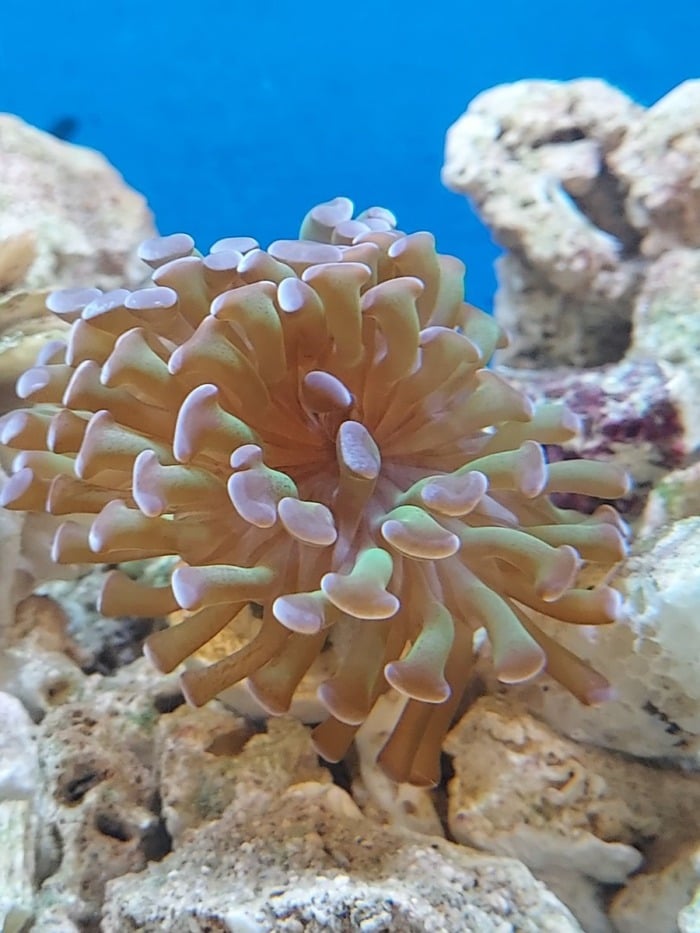
by Dude64
I should also point out that PUR is a moral reliable metric when it comes to coral lighting.
What do I mean? I discuss this in detail in my guide on LED aquarium lighting over here.
Anyways, here’s how to get the best colors out of a hammer coral:
The more light it gets the stronger the coloration and the less flow there is the more it will expand.
If you want a really bright, vivid color you should eventually provide it with more light.
Remain patient as a quick change may stress your hammerhead coral.
You should start with a medium to low light.
Each month you can scale up the intensity, by moving your coral closer to the top of the fish tank.
As much as I believe this goes without saying – do not place your hammerhead coral in a shady place.
They don’t do well under indirect light.
Related: LED Lights for Growing LPS and SPS Corals Like a Pro
Compatibility with other corals

I had a frogspawn before getting my hammer and I was concerned if they could be kept together.
These are very aggressive corals, so the last thing I needed was coral terrorism in my fish tank (my super evil maroon clownfish was enough of a bully already).
My research showed that Euphyllia corals are friendly to other members of their genus.
So I went on with that and got my hammer coral, placing it in close vicinity to my frogspawn (also Euphyllia) while hoping for the best.
Guess what – they were super happy with each other.
They expanded as usual throughout the night but there was no apparent damage to either.
I think they were even “hunting” together, so to speak.
My experience with Torches shows that they should be safe too, likely because they’re part of the same genus.
However, a very experienced friend of mine told me that torches are usually the most aggressive of all Euphyllia and would sometimes get in a fight with hammerheads and frogspawns.
This would happen if they grow large enough, battling for living space.
Giving them enough area to grow and not letting them feel crowded would eliminate the problem.
Let me know about your experience with that.
Then again, hammerhead corals will try to sting your other SPS corals.
They can kill another species of coral overnight.
Ask me how I know.
That’s why I place them no less than 7 inches away from other corals.
I also make sure to anchor them well in their place, ever since that one time, a hammer got blown away by the flow. I use a combo of epoxy putty and aquarium safe super glue (a link to a more in-depth explanation on super glue safety) to attach it to rocks.
A few tricks I learned about Hammerhead coral care

by revaltion131
The hammer coral feeding habits are something to consider.
To avoid excessive expansion feed regularly, as these corals will become really aggressive when hungry.
If you keep them starving long enough their tentacles may extend up to 10 inches in search of food!
I haven’t witnessed such a range of extension with mine, but there are reports out there claiming that it happens.
In my experience, these corals also do better in softy tanks (softy meaning with soft corals).
I have seen them enjoy themselves most if the water parameters are mainly targeted towards softies (LPS dominated tanks).
They are also calcium hungry.
If you have a tank high on Calcium the hammerhead will be of great aid in reducing the excess levels.
Here are some parameters for a happy hammerhead coral:
- 72-78°F (22 to 25.5°C)
- KH of 8 to 12
- pH between 8.1 and 8.4
- specific gravity (SG) 1.023-1.025
- needs strontium
- Calcium 400 ppm
- Magnesium 1350 ppm
Generally speaking, hammerhead corals can survive with lower levels of magnesium and don’t necessarily need supplementation.
As long as the magnesium doesn’t fall below 1200 ppm, your hammers should be fine.
However, anything below that will cause them to bleach.
Though they are feeding chiefly through photosynthesis you can still spot feed them. I have managed to keep mine happy with a variety of foods for LPS corals (a link to Aquanswers’ guide on that).
From what I’ve seen with my hammer coral growth rate can be improved significantly (up to 2 times) if they are being manually fed.

by rJ4N37
Give them Mysis, brine, or krill shrimp if you don’t want to get a specific brand of coral food.
However, they will also have an appetite for Coral Frenzy or Reef Chili, and even oyster eggs. Visit the link to my guide on these and other quality choices and give it a skim.
My Final Thoughts

If you’re like me you’ll get addicted to the whole Euphyllia thing rather quickly.
Even though it’s aggressive, the hammerhead coral is fascinating in its nature.
After you nail the spot once, your judgment about where to place them will improve.
Let me know how that went in the comments below.



